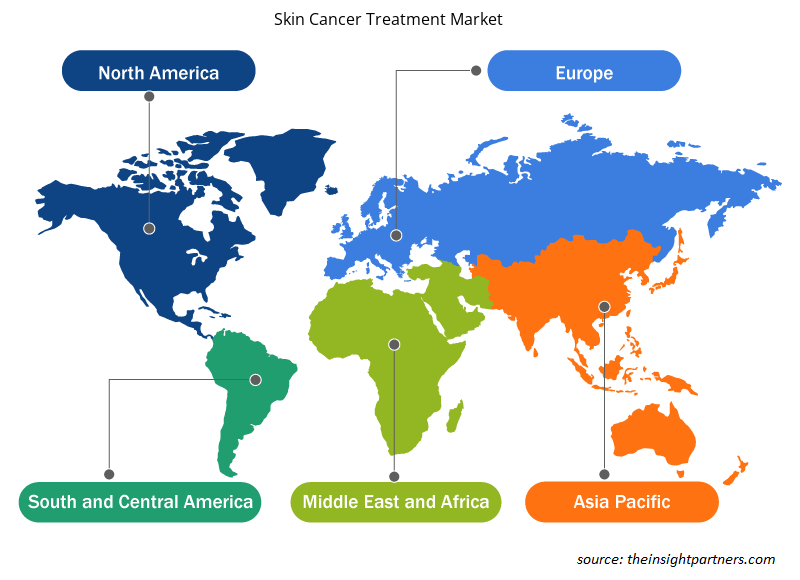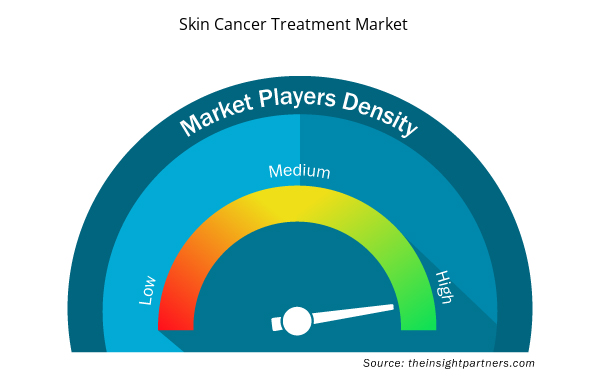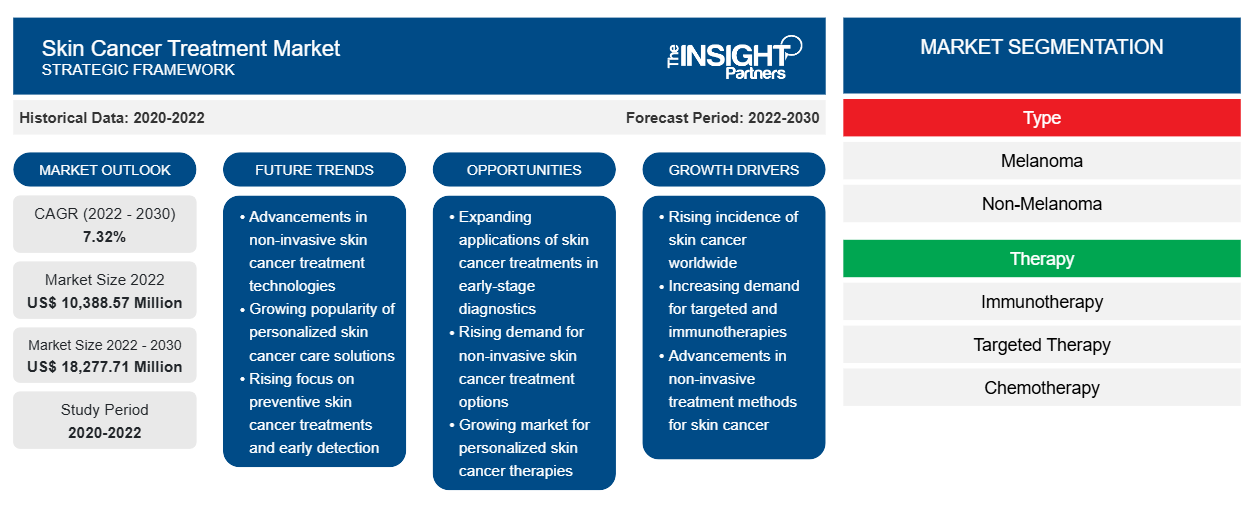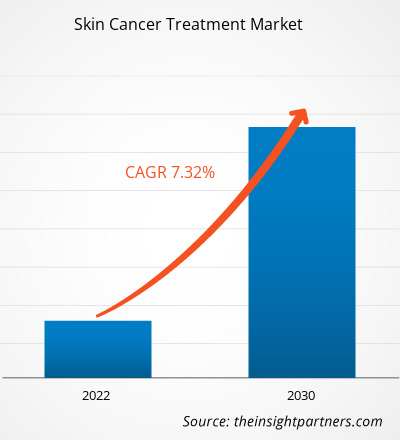[研究报告] 皮肤癌治疗市场规模预计将从 2022 年的 103.8857 亿美元增长到 2030 年的 182.7771 亿美元;预计 2022 年至 2030 年市场复合年增长率为 7.32%。
市场洞察和分析师观点:
皮肤癌治疗市场预测 可以帮助该市场的利益相关者规划其增长战略。黑色素瘤和非黑色素瘤都是皮肤癌类型。过度日光照射会导致皮肤癌。根据美国皮肤病学会的统计,皮肤癌影响五分之一的美国人。此外,据该组织称,每年有近 300 万美国人被诊断出患有非黑色素瘤皮肤癌。黑色素瘤和非黑色素瘤皮肤癌的患病率不断上升推动了市场收入。
免疫疗法、靶向疗法、化疗和放射疗法是治疗皮肤癌的可用方法。此外,5-氟尿嘧啶乳膏(被归类为化疗的一种)也用于这种治疗。然而,由于手术是治疗皮肤癌更有效的方法,因此它是首选方法此外,皮肤癌治疗市场趋势包括增加药物研发线。
增长动力和挑战:
黑色素瘤和非黑色素瘤的患病率不断上升,推动了皮肤癌治疗市场规模的扩大。黑色素瘤和非黑色素瘤的患病率不断上升,已成为推动市场增长和多样化的重要驱动力。由于皮肤癌患病率不断上升和公众意识不断提高,用于治疗皮肤癌的药物数量最近有所增加。根据美国国家医学图书馆 2022 年发布的最新数据,美国每年记录 180 万例鳞状细胞癌 (SCC) 和 360 万例基底细胞癌 (BCC) 病例。皮肤癌发病率的上升推动了对皮肤癌治疗的需求。
近年来,由于全球变暖加速,人们暴露在紫外线下的时间也随之增加。在臭氧层消耗更严重的地区,居民的皮肤癌病例数有所增加。澳大利亚癌症委员会报告称,每年由日晒引起的皮肤癌占全国报告的所有癌症病例的 80% 以上。该组织补充说,美国、英国和加拿大的皮肤癌发病率最高。此外,老年人口特别容易患上皮肤癌。据预测,这些地区老年人口的增加将支持市场扩张。
皮肤癌治疗市场面临重大挑战,因为现有治疗方式的不良影响影响了市场增长。手术、化疗、放射疗法和免疫疗法等传统治疗方法可能导致不良反应,包括皮肤刺激、全身毒性、长期并发症等。副作用会严重影响患者的生活质量,并可能阻止一些人寻求或坚持治疗。此外,当前治疗方案的局限性可能推动人们探索替代的、侵入性更小、更有针对性的皮肤癌治疗方法。随着研发活动专注于改进安全性和疗效的治疗方式,市场将见证应对这些挑战的变革性创新,为患者带来新的希望并推动市场扩张。因此,现有治疗方式的不良影响阻碍了皮肤癌治疗市场的增长。
定制此报告以满足您的需求
您可以免费定制任何报告,包括本报告的部分内容、国家级分析、Excel 数据包,以及为初创企业和大学提供优惠和折扣
- 获取此报告的关键市场趋势。这个免费样品将包括数据分析,从市场趋势到估计和预测。
报告细分和范围:
“皮肤癌治疗市场分析”考虑了以下因素细分市场:基于类型、疗法和最终用户。根据类型,市场分为黑色素瘤和非黑色素瘤。按疗法,皮肤癌治疗市场分为免疫疗法、靶向疗法、化疗、放射疗法等。按最终用户,市场分为医院、皮肤科诊所、诊断中心等。在地理方面,皮肤癌治疗市场报告分为北美(美国、加拿大和墨西哥)、欧洲(英国、德国、法国、意大利、西班牙和欧洲其他地区)、亚太地区(中国、日本、印度、澳大利亚、韩国和亚太地区其他地区)、中东和非洲(阿联酋、沙特阿拉伯、南非和中东和非洲其他地区)以及南美洲和中美洲(巴西、阿根廷和南美洲和中美洲其他地区)。
节段分析:
根据类型,皮肤癌治疗市场分为黑色素瘤和非黑色素瘤。黑色素瘤部分预计在预测期内占据更大的市场份额。皮肤上的黑色素细胞异常分裂,称为黑色素瘤皮肤癌。亚洲和欧洲一些国家黑色素瘤发病率的上升促进了该领域的市场增长。手术和放射疗法是非黑色素瘤皮肤癌的主要治疗方法。尽管如此,治疗黑色素瘤以外的皮肤癌的免疫疗法药物的推出预计将在未来几年支持该领域的市场扩张。随着非黑色素瘤治疗药物的广泛应用,市场预计将在未来几年增长。
根据治疗方法,皮肤癌治疗市场分为免疫疗法、靶向疗法、化疗、放射疗法等。考虑到放疗和化疗的副作用,免疫疗法药物被越来越多地用于治疗皮肤癌。此外,靶向疗法等治疗方案可提高皮肤癌治疗的成功率。当皮肤癌发展到其他治疗方案不可行的程度时,医生会建议免疫疗法和靶向疗法。预计这些因素将推动靶向疗法和免疫疗法的皮肤癌治疗市场增长未来几年,靶向治疗领域将占据皮肤癌治疗市场的重要份额。此外,到 2030 年,靶向治疗领域预计将占据皮肤癌治疗市场的重要份额。
区域分析:
根据地区,皮肤癌治疗市场分为北美、欧洲、亚太、中东和非洲、南美和中美。
北美是皮肤癌治疗市场增长的最大贡献者,因为美国的皮肤癌发病率较高,而且该国的抗癌药物使用率较高。此外,主要行业参与者倾向于引入新的皮肤癌治疗方法,预计将对该地区市场的扩张产生有利影响。由于非黑色素瘤皮肤癌在白种人中更为常见,北美和欧洲占据了全球市场的很大一部分。
由于澳大利亚和新西兰等国家黑色素瘤和非黑色素瘤的发病率不断上升,预计亚太地区的皮肤癌治疗市场规模将在预测期内以最高速度增长。在亚太地区,皮肤癌药物的监管批准以及发展中国家规模庞大且欠发达的市场相结合,支持了该地区皮肤癌治疗市场的扩张。由于欧洲黑色素瘤病例不断增加,预计市场收入将在预测期内健康发展。
皮肤癌治疗市场区域洞察
Insight Partners 的分析师已详细解释了预测期内影响皮肤癌治疗市场的区域趋势和因素。本节还讨论了北美、欧洲、亚太地区、中东和非洲以及南美和中美洲的皮肤癌治疗市场细分和地理位置。

- 获取皮肤癌治疗市场的区域特定数据
皮肤癌治疗市场报告范围
| 报告属性 | 细节 |
|---|---|
| 2022 年市场规模 | 103.8857亿美元 |
| 2030 年的市场规模 | 182.7771亿美元 |
| 全球复合年增长率(2022 - 2030 年) | 7.32% |
| 史料 | 2020-2022 |
| 预测期 | 2022-2030 |
| 涵盖的领域 | 按类型
|
| 覆盖地区和国家 | 北美
|
| 市场领导者和主要公司简介 |
|
皮肤癌治疗市场参与者密度:了解其对业务动态的影响
皮肤癌治疗市场正在快速增长,这得益于终端用户需求的不断增长,而这些需求又源于消费者偏好的不断变化、技术进步以及对产品优势的认识不断提高等因素。随着需求的增加,企业正在扩大其产品范围,进行创新以满足消费者的需求,并利用新兴趋势,从而进一步推动市场增长。
市场参与者密度是指在特定市场或行业内运营的企业或公司的分布情况。它表明在给定市场空间中,相对于其规模或总市场价值,有多少竞争对手(市场参与者)存在。
在皮肤癌治疗市场运营的主要公司有:
- 医科达
- 诺华公司
- F.霍夫曼罗氏有限公司
- 德玛库瑞
- Xoft(iCAD 公司)
免责声明:上面列出的公司没有按照任何特定顺序排列。

- 了解皮肤癌治疗市场顶级关键参与者概况
行业发展和未来机遇:
以下列出了全球皮肤癌治疗市场主要参与者采取的一些举措:
- 2023 年 10 月,随着美国 FDA 批准 Opdivo(nivolumab),百时美施贵宝宣布,该公司现在可以作为辅助疗法治疗完全切除的 IIB 期或 IIC 期黑色素瘤成人和 12 岁及以上的儿童患者。这扩大了 Opdivo 目前的适应症,并进一步巩固了该公司为黑色素瘤患者提供治疗选择的传统。第 3 阶段 CheckMate -76K 试验将 Opdivo(n = 526)与安慰剂(n = 264)进行了对比,这是该药物获批的基础。
- 2023 年 3 月,Zynyz 获得了美国食品药品监督管理局 (FDA) 的批准,用于治疗转移性或复发性局部晚期默克尔细胞癌 (MCC) 成人患者。根据肿瘤缓解率和缓解持续时间 (DOR),FDA 加速批准了 Zynyz;但是,Zynyz 继续获批用于该适应症可能需要在确认性试验中进行验证和描述临床益处。
竞争格局和重点公司:
默克公司、百时美施贵宝、诺华公司、罗氏公司、安进公司、葛兰素史克公司、辉瑞公司、太阳制药和再生元制药是皮肤癌治疗市场报告中的几家主要公司。这些公司专注于扩大其产品范围,以满足全球日益增长的消费者需求。它们的全球影响力使它们能够为众多客户提供服务,从而扩大其市场份额。
- 历史分析(2 年)、基准年、预测(7 年)及复合年增长率
- PEST 和 SWOT 分析
- 市场规模价值/数量 - 全球、区域、国家
- 行业和竞争格局
- Excel 数据集



Report Coverage
Revenue forecast, Company Analysis, Industry landscape, Growth factors, and Trends

Segment Covered
This text is related
to segments covered.

Regional Scope
North America, Europe, Asia Pacific, Middle East & Africa, South & Central America

Country Scope
This text is related
to country scope.
常见问题
The light therapy market was valued at US$ 10,388.57 million in 2022.
The light therapy market has major market players, including Merck & Co., Bristol Mayers Squibb, Novartis AG, Roche, Amgen Inc., GSK, Pfizer Inc., Sun Pharmaceutical, and Regeneron Pharmaceuticals.
Melanoma and non-melanoma are skin cancer types. Excessive sunlight exposure can cause skin cancer. As per the American Academy of Dermatology Association, skin cancer affects one in five Americans. Furthermore, according to the group, almost 3 million Americans receive a diagnosis of non-melanoma skin cancer annually. Growing prevalence of melanoma and non-melanoma skin cancer drives the market revenue.
Based on therapy, the skin cancer treatment market is segmented into immunotherapy, targeted therapy, chemotherapy, radiation therapy, and others. Considering the adverse effects of radiation and chemotherapy, immunotherapy medications are being utilized more often to treat skin cancer. Furthermore, treatment options, such as targeted therapy, improve skin cancer treatment success. When skin cancer has advanced to the point where other treatment options are not practical, physicians propose immunotherapy and targeted therapy. It is expected that these factors will boost the skin cancer treatment market growth for the targeted therapy and immunotherapy segments in the coming years.
The light therapy market is expected to be valued at US$ 18,277.71 million in 2030.
Based on type, the skin cancer treatment market is bifurcated into melanoma and non-melanoma. The melanoma segment is expected to hold a larger market share during the forecast period. Melanocytes on the skin divide abnormally, known as melanoma skin cancer. Rising incidence of melanoma in several Asian and European countries bolsters the market growth for the segment. Surgery and radiation therapy are main treatments for non-melanoma skin cancer. Nonetheless, the launch of immunotherapy medications to treat skin cancer other than melanoma is anticipated to support the market expansion for the segment in the next years. The market is expected to grow in the coming years as therapeutic medications for non-melanoma treatment become widely available..
The increasing prevalence of melanoma and non-melanoma has emerged as a significant driver propelling the growth and diversification of the skin cancer treatment market. The number of medications used to treat skin cancer has increased recently as a result of the growing prevalence of the disease and rising public awareness.
Trends and growth analysis reports related to Life Sciences : READ MORE..
The List of Companies - Skin Cancer Treatment Market
- Elekta
- Novartis AG
- F.Hoffmann La-Roche Ltd.
- Dermacure-rt
- Xoft (iCAD, Inc.)
- Merck KGaA
- GalaxoSmithKline plc.
- Amgen, Inc.
- Eli Lily and Company
- Sun PharmaceuticalsMerck & Co.
The Insight Partners performs research in 4 major stages: Data Collection & Secondary Research, Primary Research, Data Analysis and Data Triangulation & Final Review.
- Data Collection and Secondary Research:
As a market research and consulting firm operating from a decade, we have published and advised several client across the globe. First step for any study will start with an assessment of currently available data and insights from existing reports. Further, historical and current market information is collected from Investor Presentations, Annual Reports, SEC Filings, etc., and other information related to company’s performance and market positioning are gathered from Paid Databases (Factiva, Hoovers, and Reuters) and various other publications available in public domain.
Several associations trade associates, technical forums, institutes, societies and organization are accessed to gain technical as well as market related insights through their publications such as research papers, blogs and press releases related to the studies are referred to get cues about the market. Further, white papers, journals, magazines, and other news articles published in last 3 years are scrutinized and analyzed to understand the current market trends.
- Primary Research:
The primarily interview analysis comprise of data obtained from industry participants interview and answers to survey questions gathered by in-house primary team.
For primary research, interviews are conducted with industry experts/CEOs/Marketing Managers/VPs/Subject Matter Experts from both demand and supply side to get a 360-degree view of the market. The primary team conducts several interviews based on the complexity of the markets to understand the various market trends and dynamics which makes research more credible and precise.
A typical research interview fulfils the following functions:
- Provides first-hand information on the market size, market trends, growth trends, competitive landscape, and outlook
- Validates and strengthens in-house secondary research findings
- Develops the analysis team’s expertise and market understanding
Primary research involves email interactions and telephone interviews for each market, category, segment, and sub-segment across geographies. The participants who typically take part in such a process include, but are not limited to:
- Industry participants: VPs, business development managers, market intelligence managers and national sales managers
- Outside experts: Valuation experts, research analysts and key opinion leaders specializing in the electronics and semiconductor industry.
Below is the breakup of our primary respondents by company, designation, and region:

Once we receive the confirmation from primary research sources or primary respondents, we finalize the base year market estimation and forecast the data as per the macroeconomic and microeconomic factors assessed during data collection.
- Data Analysis:
Once data is validated through both secondary as well as primary respondents, we finalize the market estimations by hypothesis formulation and factor analysis at regional and country level.
- Macro-Economic Factor Analysis:
We analyse macroeconomic indicators such the gross domestic product (GDP), increase in the demand for goods and services across industries, technological advancement, regional economic growth, governmental policies, the influence of COVID-19, PEST analysis, and other aspects. This analysis aids in setting benchmarks for various nations/regions and approximating market splits. Additionally, the general trend of the aforementioned components aid in determining the market's development possibilities.
- Country Level Data:
Various factors that are especially aligned to the country are taken into account to determine the market size for a certain area and country, including the presence of vendors, such as headquarters and offices, the country's GDP, demand patterns, and industry growth. To comprehend the market dynamics for the nation, a number of growth variables, inhibitors, application areas, and current market trends are researched. The aforementioned elements aid in determining the country's overall market's growth potential.
- Company Profile:
The “Table of Contents” is formulated by listing and analyzing more than 25 - 30 companies operating in the market ecosystem across geographies. However, we profile only 10 companies as a standard practice in our syndicate reports. These 10 companies comprise leading, emerging, and regional players. Nonetheless, our analysis is not restricted to the 10 listed companies, we also analyze other companies present in the market to develop a holistic view and understand the prevailing trends. The “Company Profiles” section in the report covers key facts, business description, products & services, financial information, SWOT analysis, and key developments. The financial information presented is extracted from the annual reports and official documents of the publicly listed companies. Upon collecting the information for the sections of respective companies, we verify them via various primary sources and then compile the data in respective company profiles. The company level information helps us in deriving the base number as well as in forecasting the market size.
- Developing Base Number:
Aggregation of sales statistics (2020-2022) and macro-economic factor, and other secondary and primary research insights are utilized to arrive at base number and related market shares for 2022. The data gaps are identified in this step and relevant market data is analyzed, collected from paid primary interviews or databases. On finalizing the base year market size, forecasts are developed on the basis of macro-economic, industry and market growth factors and company level analysis.
- Data Triangulation and Final Review:
The market findings and base year market size calculations are validated from supply as well as demand side. Demand side validations are based on macro-economic factor analysis and benchmarks for respective regions and countries. In case of supply side validations, revenues of major companies are estimated (in case not available) based on industry benchmark, approximate number of employees, product portfolio, and primary interviews revenues are gathered. Further revenue from target product/service segment is assessed to avoid overshooting of market statistics. In case of heavy deviations between supply and demand side values, all thes steps are repeated to achieve synchronization.
We follow an iterative model, wherein we share our research findings with Subject Matter Experts (SME’s) and Key Opinion Leaders (KOLs) until consensus view of the market is not formulated – this model negates any drastic deviation in the opinions of experts. Only validated and universally acceptable research findings are quoted in our reports.
We have important check points that we use to validate our research findings – which we call – data triangulation, where we validate the information, we generate from secondary sources with primary interviews and then we re-validate with our internal data bases and Subject matter experts. This comprehensive model enables us to deliver high quality, reliable data in shortest possible time.


 获取此报告的免费样本
获取此报告的免费样本